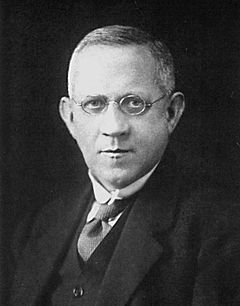Martin Lowry facts for kids
Quick facts for kids
Thomas Martin Lowry
|
|
|---|---|

Lowry, c. 1910
|
|
| Born | 26 October 1874 |
| Died | 2 November 1936 (aged 62) Cambridge, UK
|
| Nationality | British |
| Known for | Brønsted–Lowry acid–base theory |
| Awards | Fellow of the Royal Society |
| Scientific career | |
| Fields | Physical chemistry |
| Doctoral advisor | Henry Edward Armstrong |
Thomas Martin Lowry (born October 26, 1874 – died November 2, 1936) was an important English physical chemist. He is famous for helping to create the Brønsted–Lowry acid–base theory. He worked on this idea at the same time as another scientist, Johannes Nicolaus Brønsted. Lowry also helped start the Faraday Society and was its president from 1928 to 1930.
Contents
Early Life and Education
Thomas Martin Lowry was born on October 26, 1874, in Low Moor, Bradford, England. His family was from Cornwall. His father, Reverend E. P. Lowry, was a minister.
Thomas went to Kingswood School in Bath. Later, he studied at the Central Technical College in South Kensington. During his studies, he realized he wanted to be a chemist.
Studying Chemistry
Lowry studied chemistry under Henry Edward Armstrong. Armstrong was an English chemist who was very interested in organic chemistry. He also studied how ions behave in aqueous solutions (water solutions).
From 1896 to 1913, Lowry worked as Armstrong's assistant. Between 1904 and 1913, he also taught chemistry at the Westminster Training College.
Career and Achievements
In 1913, Thomas Lowry became the head of the chemistry department at Guy’s Hospital. This was a medical school. He was the first chemistry teacher in a medical school to become a University Professor at the University of London.
From 1920 until he passed away, Lowry was a Professor of Physical Chemistry at the University of Cambridge.
Contributions to Societies
Lowry was very active in the Faraday Society from when it started in 1903. He was even its president from 1928 to 1930. In 1914, he was chosen as a fellow of the Royal Society. This is a very respected group for scientists.
War Efforts and Awards
During and after World War I, Lowry helped with the war effort. He worked on committees dealing with chemical warfare and ordnance (military supplies). For his important service, he received special awards. These included the Order of the British Empire.
Key Scientific Discoveries
In 1898, Lowry noticed something interesting about a substance called nitro-d-camphor. He saw that its optical rotation changed over time. He created the word mutarotation to describe this effect.
Acids and Bases Theory
Lowry studied how acids and bases changed the optical rotation of certain chemicals. This research led to his most famous discovery in 1923. He developed a new way to define acids and bases. This idea is now known as the Brønsted–Lowry acid–base theory. He came up with this idea on his own, at the same time as Johannes Nicolaus Brønsted.
Published Works
Thomas Lowry wrote many scientific papers and several books. His book "Optical Rotatory Power" (published in 1935) was considered a very important book on that topic for a long time.


